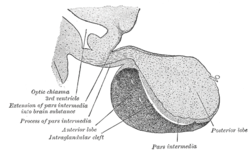Pituitary gland, anterior
| Anterior pituitary gland | |
|---|---|

Median sagittal through the hypophysis of an adult monkey. Semidiagrammatic.
|
|
| Details | |
| Precursor | oral mucosa (Rathke's pouch) |
| Artery | superior hypophyseal |
| Vein | hypophyseal |
| Identifiers | |
| Latin | lobus anterior hypophysis |
| MeSH | D010903 |
| NeuroNames | 407 |
| NeuroLex ID | birnlex_1581 |
| TA | A11.1.00.002 |
| FMA | 74627 |
|
Anatomical terminology
[]
|
|
A major organ of the endocrine system, the anterior pituitary (also called the adenohypophysis or pars anterior), is the glandular, anterior lobe that together with the posterior lobe (posterior pituitary, or the neurohypophysis) makes up the pituitary gland (hypophysis). The anterior pituitary regulates several physiological processes including stress, growth, reproduction and lactation. Proper functioning of the anterior pituitary and of the organs it regulates can often be ascertained via blood tests that measure hormone levels.
The pituitary gland is a pea-sized gland that sits in a protective bony enclosure called the sella turcica (Turkish chair/saddle). It is composed of three lobes: the anterior, intermediate, and posterior lobes. In many animals, these lobes are distinct. However, in humans, the intermediate lobe is but a few cell layers thick and indistinct; as a result, it is often considered as part of the anterior pituitary. In all animals, the fleshy, glandular anterior pituitary is distinct from the neural composition of the posterior pituitary.
The anterior pituitary is composed of three regions:
Nota bene: The term "Basophil" and "Acidophil" is used by some books, whereas others prefer to not use these terms. This is due to the possible confusion with white blood cells, where one may also find Basophils and Acidophils.
The anterior pituitary is derived from the ectoderm, more specifically from that of Rathke’s pouch, part of the developing hard palate in the embryo.
...
Wikipedia
